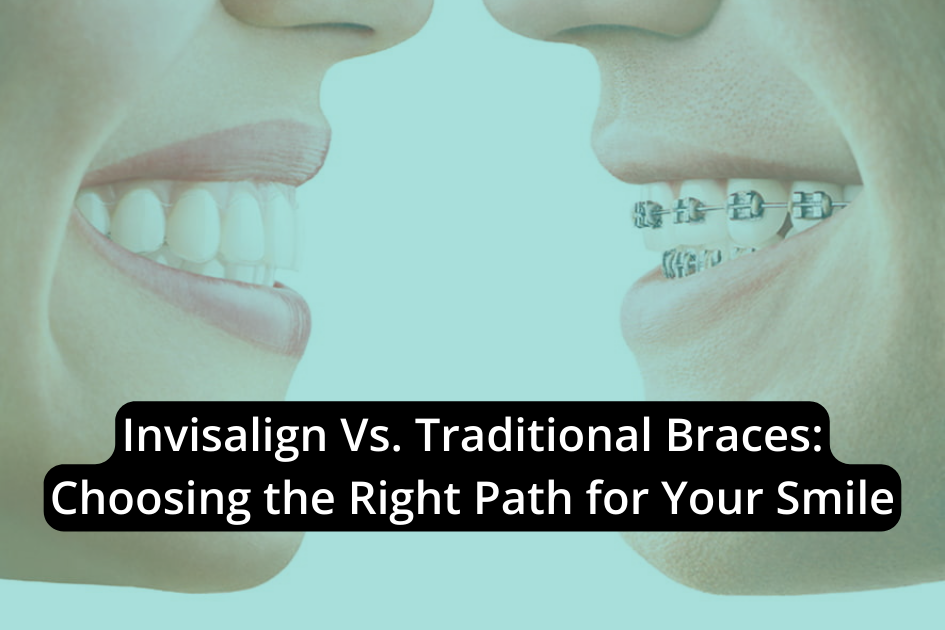Are you aware that braces adorn the teeth of more than 4 million people across the U.S.?
When you seek a brighter smile, the debate between Invisalign and traditional braces becomes inevitable. Each choice brings a different set of benefits and challenges.
Invisalign shines with near invisibility and simple upkeep. On the other side, traditional braces boast a history of successful, comprehensive corrections.
The selection isn’t purely about looks, but it also includes considerations such as treatment duration, expense, and lifestyle effects. We aim to offer clarity on these differences, clear misconceptions, and aid you in making an informed decision for your brighter smile.
Understanding Traditional Braces
Traditional braces might be seen by some as an outdated method, yet they provide a reliable strategy for aligning your teeth. Built from metal brackets and wires, these braces apply force to tooth ligaments to slowly but surely straighten your teeth. Each month, manual adjustments encourage the desired tooth movement. This method, though effective, can span over two years or more, which is quite a bit longer than the time required for Invisalign treatment.
Maintaining cleanliness with these braces calls for regular brushing and flossing, a regimen that may be difficult for some. Food restrictions also play a vital role in the journey with traditional braces, restricting your ability to indulge in certain foods. Frequent orthodontic appointments for adjustments introduce another level of dedication to this treatment.
Even with these factors in mind, the price of traditional braces sits at a level comparable to Invisalign. Thus, it’s less about the cost and more about personal comfort when aiming for a perfect smile. It’s worth noting that, though traditional braces may bring initial discomfort, they’ve proven their worth over time, aiding millions in acquiring their dream smiles. The key lies in assessing the advantages and disadvantages, then arriving at a knowledgeable choice.
The Rise of Invisalign
Your journey toward a polished and self-assured grin is now a breeze, owing to the emergence of Invisalign. This groundbreaking orthodontic therapy offers a refined and nearly invisible method for aligning your teeth. It’s an ideal mix of comfort, convenience, and effectiveness, illustrating why its appeal has surged in recent years.
Invisalign’s triumph is partly due to its distinctive characteristics that differentiate it from conventional braces:
- The SmartTrack material utilized in Invisalign aligners is both cozy and incredibly efficient. It’s discreet enough to uphold your professional appearance while subtly altering your grin.
- Invisalign employs digital technology granting a high degree of customization. This allows you to view a digital model of your anticipated smile and track your therapy progress.
- Invisalign provides a faster route to flawlessness. Aesthetic procedures can be finished within 3-6 months, making it a more economical option for shorter therapies.
The popularity of Invisalign isn’t just about beauty or convenience. It symbolizes a shift in orthodontic therapy, giving you command, swiftness, and subtlety in obtaining that flawless grin.

Comparing Aesthetics and Comfort
Exploring the juxtaposition of aesthetics and comfort necessitates a detailed look at Invisalign and conventional braces. From an aesthetic perspective, Invisalign holds a clear edge. Its aligners are practically unnoticeable, offering a streamlined and unobtrusive solution for orthodontic treatment with no impact on your appearance. This positions it as a prime option for those wanting to uphold a professional image.
In contrast, conventional braces, with their conspicuous metal brackets and wires, fall short. They’re quite visible and could induce a sense of self-consciousness in some individuals during their smile’s transformation.
Comfort is another domain where Invisalign surpasses conventional braces. Invisalign aligners are crafted from a smooth SmartTrack material intended to reduce discomfort. They lack the sharp edges that could scratch or irritate your mouth, a potential issue with conventional braces that could lead to discomfort or even harm.
What’s more, Invisalign aligners can be taken out, providing you the liberty to consume your preferred food without any concerns. This advantage, along with less frequent orthodontist appointments, positions Invisalign as a more comfortable and convenient option for many.
In the pursuit of a flawless smile, it’s essential to consider not just the final outcome but the path you’ll embark on to achieve it.
Treatment Duration and Effectiveness
When discussing treatment duration and effectiveness, it’s evident significant contrasts exist between Invisalign and traditional braces. Invisalign generally boasts a shorter treatment duration, typically spanning 6 months to 2 years, while traditional braces might demand 1-3 years for completion. This discrepancy is largely attributed to Invisalign’s proficiency in treating complex cases within a limited time frame.
Invisalign permits greater flexibility in treatment progress and control, thus facilitating speedier and more predictable tooth movement compared to traditional braces. This introduces the three defining factors that differentiate these two methods:
- Treatment Speed: Invisalign’s expedited treatment time proves beneficial for those seeking a swift route to a flawless smile.
- Visit Frequency: Traditional braces necessitate monthly adjustments, in contrast, Invisalign wearers commence a new set of aligners bi-weekly, diminishing the requirement for regular orthodontist appointments.
- Predictability: Invisalign’s clinically validated record exhibits its capability to shift teeth more rapidly and with enhanced predictability than traditional braces.
Hence, when deciding between Invisalign and traditional braces, these factors should influence your selection for your smile.
Maintenance and Lifestyle Considerations
Pondering over orthodontic treatment, one must evaluate the maintenance and lifestyle implications of the selected option. Traditional braces demand adaptation to regular cleaning routines and dietary modifications, while handling Invisalign aligners necessitates removal during meals and thorough cleaning afterward.
Each choice asks for a different level of commitment, hence, your everyday routine and lifestyle should guide your decision.
Caring for Traditional Braces
When managing traditional braces, understanding the importance of regular cleaning with a specialized floss threader and routine dental visits becomes critical for brace maintenance.
- Flossing: Proper oral hygiene necessitates flossing under the wire and between the brackets. A floss threader can simplify and expedite this process.
- Avoiding Certain Foods: Foods that are hard or sticky can compromise the brackets and wires. Steer clear from such foods to maintain the longevity and functionality of your braces.
- Regular Orthodontic Visits: Scheduled monthly or bi-monthly orthodontic appointments are needed for adjustments and progress monitoring. These appointments play a vital role in ensuring your braces work effectively.
The success of your braces greatly hinges on your dedication to care and maintenance.
Managing Invisalign Aligners
Switching from traditional braces, let’s explore how you handle Invisalign aligners and the lifestyle considerations.
The expectation is for you to wear your aligners for 22 hours a day, removing them strictly for meals.
Maintaining them demands regular cleaning, which includes brushing and soaking, to ward off the accumulation of food or bacteria.
While there’s a risk of losing or damaging your aligners, careful handling and compliance are vital for successful treatment.
Differing from traditional braces, Invisalign necessitates fewer orthodontist visits, typically every three months, and commencing a new set of aligners every two weeks.
The process requires discipline in regular oral care and consistent wear of your aligners for superior results.

Making the Decision: Invisalign or Braces
Choosing between Invisalign and traditional braces necessitates a thorough evaluation of your lifestyle, personal preferences, and dental health requirements. Each option presents its own set of pros and cons, with the optimal decision varying based on individual circumstances.
Several primary factors should guide your decision:
- Treatment Duration: The usual treatment period for traditional braces ranges from 1 to 3 years. Invisalign, however, can offer results in as little as 6 months or up to 2 years. For those seeking a rapid solution, Invisalign could be a preferable alternative.
- Ease of Removal and Upkeep: Traditional braces are non-removable and come with restrictions on food consumption and a requirement for frequent orthodontist appointments. Yet, Invisalign aligners can be removed, must be worn for 22 hours daily, and demand meticulous cleaning.
- Frequency of Orthodontist Appointments: Regular braces necessitate monthly or bi-monthly visits to the orthodontist. Contrarily, Invisalign dictates appointments every three months and the initiation of a fresh set of aligners every fortnight.
The final decision between Invisalign and traditional braces is highly personal. Discussion with your orthodontist is vital to make a well-informed decision that aligns with your lifestyle and dental health requirements.
Conclusion
Ultimately, the selection between Invisalign and traditional braces hinges on your specific smile. Remember that while beauty is superficial, a healthy grin penetrates to the bone. Take into account aesthetic factors, comfort, duration of treatment, and implications for your lifestyle before deciding.
Your flawless grin justifies the time and consideration, so choose with wisdom. Regardless of the route you opt for, each stage will take you nearer to the bright, self-assured smile you merit.





